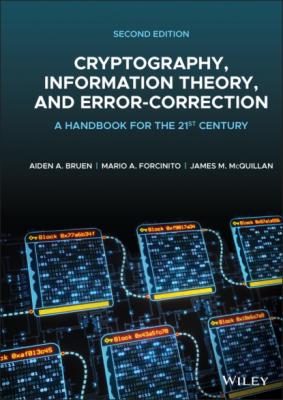Cryptography, Information Theory, and Error-Correction. Aiden A. Bruen
Читать онлайн.| Название | Cryptography, Information Theory, and Error-Correction |
|---|---|
| Автор произведения | Aiden A. Bruen |
| Жанр | Зарубежная компьютерная литература |
| Серия | |
| Издательство | Зарубежная компьютерная литература |
| Год выпуска | 0 |
| isbn | 9781119582403 |
rel="nofollow" href="#ulink_5be654e5-b555-51b1-a5ed-402cc8061885">10.13 Subadditivity of the Function –x log x
10.14 Entropy and Cryptography
10.15 Problems
10.16 Solutions
Chapter 11: Source Coding, Redundancy
11.1 Introduction, Source Extensions
11.2 Encodings, Kraft, McMillan
11.3 Block Coding, the Oracle, Yes–No Questions
11.4 Optimal Codes
11.5 Huffman Coding
11.6 Optimality of Huffman Coding
11.7 Data Compression, Redundancy
11.8 Problems
11.9 Solutions
Chapter 12: Channels, Capacity, the Fundamental Theorem
12.1 Abstract Channels
12.2 More Specific Channels
12.3 New Channels from Old, Cascades
12.4 Input Probability, Channel Capacity
12.5 Capacity for General Binary Channels, Entropy
12.6 Hamming Distance
12.7 Improving Reliability of a Binary Symmetric Channel
12.8 Error Correction, Error Reduction, Good Redundancy
12.9 The Fundamental Theorem of Information Theory
12.10 Proving the Fundamental Theorem
12.11 Summary, the Big Picture
12.12 Postscript: The Capacity of the Binary Symmetric Channel
12.13 Problems
12.14 Solutions
Chapter 13: Signals, Sampling, Coding Gain, Shannon's Information Capacity Theorem
13.1 Continuous Signals, Shannon's Sampling Theorem
13.2 The Band‐Limited Capacity Theorem
13.3 The Coding Gain
Chapter 14: Ergodic and Markov Sources, Language Entropy
14.1 General and Stationary Sources
14.2 Ergodic Sources
14.3 Markov Chains and Markov Sources
14.4 Irreducible Markov Sources, Adjoint Source
14.5 Cascades and the Data Processing Theorem
14.6 The Redundancy of Languages
14.7 Problems
14.8 Solutions
Chapter 15: Perfect Secrecy: The New Paradigm
15.1 Symmetric Key Cryptosystems
15.2 Perfect Secrecy and Equiprobable Keys
15.3 Perfect Secrecy and Latin Squares
15.4 The Abstract Approach to Perfect Secrecy
15.5 Cryptography, Information Theory, Shannon
15.6 Unique Message from Ciphertext, Unicity
15.7 Problems
15.8 Solutions
Chapter 16: Shift Registers (LFSR) and Stream Ciphers
16.1 Vernam Cipher, Psuedo‐Random Key
16.2 Construction of Feedback Shift Registers
16.3 Periodicity
16.4 Maximal Periods, Pseudo‐Random Sequences
16.5 Determining the Output from 2m Bits
16.6 The Tap Polynomial and the Period
16.7 Short Linear Feedback Shift Registers and the Berlekamp‐Massey Algorithm
16.8 Problems
16.9 Solutions
Chapter 17: Compression and Applications
17.1 Introduction, Applications
17.2 The Memory Hierarchy of a Computer
17.3 Memory Compression
17.4 Lempel–Ziv Coding
17.5 The WKdm Algorithms
17.6 Main Memory – to Compress or Not to Compress
17.7 Problems
17.8 Solutions
12 Part III: Mainly Error‐Correction Chapter 18: Error‐Correction, Hadamard, and Bruen–Ott 18.1 General Ideas of Error Correction 18.2 Error Detection, Error Correction 18.3
